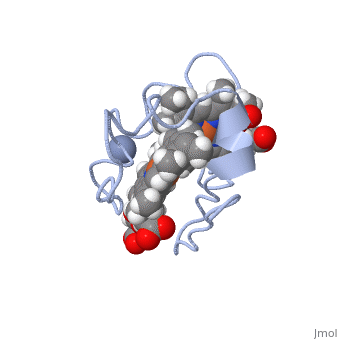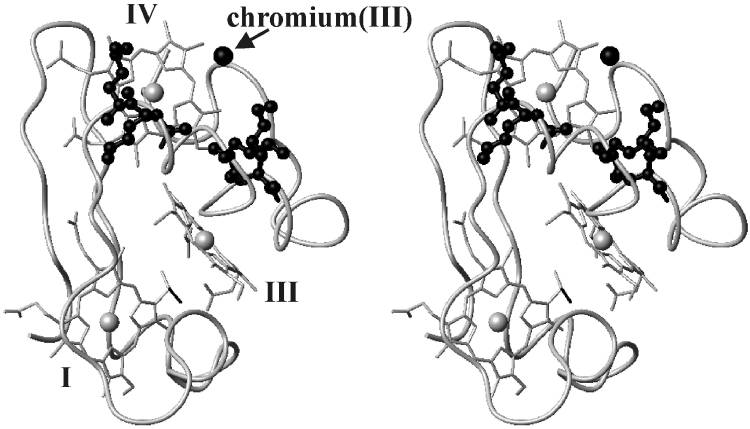Cytochrome c 7
From Proteopedia
(Difference between revisions)
| Line 1: | Line 1: | ||
==General== | ==General== | ||
| - | <StructureSection load='1LM2.pdb' size='340' side='right' caption='3D Structure of Cytochrome c | + | <StructureSection load='1LM2.pdb' size='340' side='right' caption='3D Structure of Cytochrome c 7with heme and Cr+3 ion (PDB code [[1lm2]])' scene=''> |
'''Cytocrhome c 7''' (Cc7) is a three heme-containing protein derived from the sulfur-reducing bacterium ''Desulfuromonas acetoxidans''. Cc7 is crucial to the bacteria's anaerobic sulfur respiration as it plays a role in the electron-transfer mechanism, and as such it is located in the mitochondrial inter-membrane space<ref name="assfalt">Assfalg M, Bertini I, Bruschi M, Michel C, Turano P. The metal reductase activity of some multiheme cytochromes c: NMR structural characterization of the reduction of chromium(VI) to chromium(III) by cytochrome c(7). 2002; 99(15):9750-4 '''[http://www.ncbi.nlm.nih.gov/pmc/articles/PMC125002/''' DOI: 10.1073/pnas.152290999''']'''</ref>. Over the course of 3.5 million years, ''Desulfuromonas acetoxidans'' have evolved to use anaerobic sulfur respiration as the main driving force of their survival<ref>Barton L, Fauque G. Biochemistry, Physiology and Biotechnology of Sulfate-Reducing Bacteria. Advances in Applied Microbiology. 2009; 68: 41–98. '''[http://www.sciencedirect.com/science/article/pii/S0065216409012027''' DOI: 10.1016/s0065-2164(09)01202-7''']'''</ref>. | '''Cytocrhome c 7''' (Cc7) is a three heme-containing protein derived from the sulfur-reducing bacterium ''Desulfuromonas acetoxidans''. Cc7 is crucial to the bacteria's anaerobic sulfur respiration as it plays a role in the electron-transfer mechanism, and as such it is located in the mitochondrial inter-membrane space<ref name="assfalt">Assfalg M, Bertini I, Bruschi M, Michel C, Turano P. The metal reductase activity of some multiheme cytochromes c: NMR structural characterization of the reduction of chromium(VI) to chromium(III) by cytochrome c(7). 2002; 99(15):9750-4 '''[http://www.ncbi.nlm.nih.gov/pmc/articles/PMC125002/''' DOI: 10.1073/pnas.152290999''']'''</ref>. Over the course of 3.5 million years, ''Desulfuromonas acetoxidans'' have evolved to use anaerobic sulfur respiration as the main driving force of their survival<ref>Barton L, Fauque G. Biochemistry, Physiology and Biotechnology of Sulfate-Reducing Bacteria. Advances in Applied Microbiology. 2009; 68: 41–98. '''[http://www.sciencedirect.com/science/article/pii/S0065216409012027''' DOI: 10.1016/s0065-2164(09)01202-7''']'''</ref>. | ||
Revision as of 17:42, 5 January 2016
General
| |||||||||||
References
- ↑ 1.0 1.1 1.2 1.3 1.4 1.5 1.6 Assfalg M, Bertini I, Bruschi M, Michel C, Turano P. The metal reductase activity of some multiheme cytochromes c: NMR structural characterization of the reduction of chromium(VI) to chromium(III) by cytochrome c(7). 2002; 99(15):9750-4 DOI: 10.1073/pnas.152290999
- ↑ Barton L, Fauque G. Biochemistry, Physiology and Biotechnology of Sulfate-Reducing Bacteria. Advances in Applied Microbiology. 2009; 68: 41–98. DOI: 10.1016/s0065-2164(09)01202-7
- ↑ 3.0 3.1 Pfennig N, Biebl H. Desulfuromonas acetoxidans gen. nov. and sp. nov., a new anaerobic, sulfur-reducing, acetate-oxidizing bacterium. 1976; 110(1): 3-12 DOI: 10.1007/BF00416962


